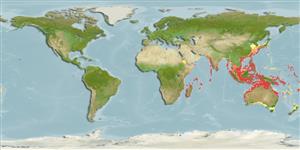>
Syngnathiformes (Pipefishes and seahorses) >
Syngnathidae (Pipefishes and seahorses) > Syngnathinae
Etymology: Halicampus: Greek, als, alis = salt + Greek, kampe = bend (Ref. 45335).
More on author: Kaup.
Environment: milieu / climate zone / depth range / distribution range
पारिस्थितिकी
समुद्री; खारा प्रवाल-भित्ति संयुक्त; गहराई सीमा ? - 100 m (Ref. 48635). Tropical
Indo-West Pacific: Gulf of Aden, off Sri Lanka, and from the Gulf of Thailand and Australia to Kyûshû Islands, Japan.
आकार / वज़न / Age
Maturity: Lm ? range ? - ? cm
Max length : 20.0 cm SL पुल्लिंग / अलिंग; (Ref. 5316)
Short description
आकृति विज्ञान | मौरफोमैटरिक्स
पृष्ठीय सौफट रेज़ (सम्पूर्ण): 19-22; ऐनल सौफट रेज़: 4. Short-snouted species with large eyes (Ref. 48635).
Adults live in muddy habitats, often covered with silt and extremely well-camouflaged (Ref. 48635). Planktonic specimens taken in the upper 0 to 100 m over depths to at least 2980 m while the demersal fish have been taken in SCUBA and trawl collections from 9 to 91.4 m. Ovoviviparous (Ref. 205). Males exhibit parental care by incubating and guarding the eggs in their brood pouch (Ref. 43081).
Life cycle and mating behavior
परिपक्व अवधि | पुनरुत्पत्ति | मछलीऔ का अंडे देना | अंडे | Fecundity | लार्वा
Males carry the eggs in the brood pouch (Ref. 205).
Dawson, C.E., 1985. Indo-Pacific pipefishes (Red Sea to the Americas). The Gulf Coast Research Laboratory Ocean Springs, Mississippi, USA. (Ref. 5316)
IUCN Red List Status (Ref. 130435)
Threat to humans
Harmless
Human uses
अधिक जानकारी
संदर्भजलीयकृषिजलीयकृषि रूपरेखाखींचआनुवंशिकीElectrophoresesहैरेटिबिलटीबीमारीप्रक्रमणNutrientsMass conversion
सहयोगीयोतस्वीरेStamps, Coins Misc.ध्वनिसिगुयटिरारफ्तारतैरने के प्रकारगिल क्षेत्रOtolithsदिमागदृष्टि
साधन
Special reports
Download XML
इंटरनेट स्रोत
Estimates based on models
Preferred temperature (Ref.
123201): 24.3 - 29, mean 27.8 °C (based on 1194 cells).
Phylogenetic diversity index (Ref.
82804): PD
50 = 0.5002 [Uniqueness, from 0.5 = low to 2.0 = high].
Bayesian length-weight: a=0.00037 (0.00016 - 0.00085), b=3.18 (2.99 - 3.37), in cm total length, based on LWR estimates for this (Sub)family-body shape (Ref.
93245).
Trophic level (Ref.
69278): 3.3 ±0.44 se; based on food items.
लौटाव (Ref.
120179): ऊंचा, न्यूनतम जनसंख्या दुगनी समय अवलागत 15 महीने। (Preliminary K or Fecundity.).
Fishing Vulnerability (Ref.
59153): Low vulnerability (14 of 100).
Nutrients (Ref.
124155): Calcium = 84.8 [48.1, 169.2] mg/100g; Iron = 0.726 [0.429, 1.210] mg/100g; Protein = 18.1 [17.0, 19.3] %; Omega3 = 0.137 [0.081, 0.247] g/100g; Selenium = 37.9 [19.4, 89.4] μg/100g; VitaminA = 74 [25, 221] μg/100g; Zinc = 1.71 [1.17, 2.39] mg/100g (wet weight);
